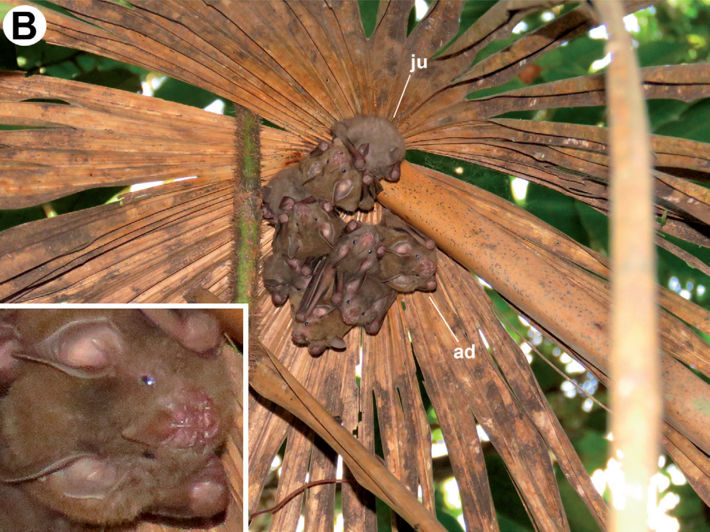Use of Mauritia flexuosa (Arecaceae) leaves as day roost by the Dwarf Little Fruit Bat Rhinophylla pumilio (Phyllostomidae) in Mato Grosso, Brazil
DOI:
https://doi.org/10.31687/saremNMS.20.0.15Resumo
Neste estudo, descrevemos um grupo de morcegos da espécie Rhinophylla pumilio utilizando a palmeira buriti (Mauritia flexuosa) como abrigo diurno em uma área de Cerrado em Cuiabá, Mato Grosso, Brasil. Com dez indivíduos empoleirados em uma folha seca de buriti, nós estimamos que este grupo era composto de cinco fêmeas e seus filhotes. Este é o primeiro registro do uso de folhas de M. flexuosa por R. pumilio é a terceira publicação a reportar o uso de folhas de buriti como abrigo para morcegos Phyllostomidae.
Referências
Garbino, G. S. T., & V. da C. Tavares. 2018. Roosting ecology of Stenodermatinae bats (Phyllostomidae): Evolution of foliage roosting and correlated phenotypes. Mammal Review 48:75–89.
Henry, M., & E. K. V. Kalko. 2007. Foraging strategy and breeding constraints of Rhinophylla pumilio (Phyllostomidae) in the Amazon lowlands. Journal of Mammalogy 88:81–93.
Kunz, T. H., & G. F. McCracken. 1996. Tents and harems: apparent defense of foliage roosts by tent-making bats. Journal of Tropical Ecology 12:121–137.
Marinkelle, C. J., & A. Cadena. 1972. Notes on bats new to the fauna of Colombia. Mammalia 36:50–58.
McLellan, L. J., & K. F. Koopman. 2008. Subfamily Carolliinae Miller, 1924. Mammals of South America, Volume 1: Marsupials, xenarthrans, shrews, and bats (A. L. Gardner, ed.). The University of Chicago Press, Chicago, IL and UK.
Morellato, L. P. C., M. G. G. Camargo, & E. Gressler. 2013. A review of plant phenology in South and Central America. Phenology: An Integrative Environmental Science (M. D. Schwartz, ed.). Springer, New York.
Peracchi, A. L., & S. T. Albuquerque. 1993. Quirópteros do municipio de Linhares, estado do Espírito Santo, Brasil (Mammalia, Chiroptera). Revista Brasileira de Biologia 53:575–581.
Peracchi, A. L., S. D. L. Raimundo, & A. M. Tannure. 1984. Quirópteros do Território Federal do Amapá, Brasil (Mammalia, Chiroptera). Arquivos da Universidade Federal Rural do Rio de Janeiro 7:89–100.
Reis, N. R., & A. L. Peracchi. 1987. Quiropteros da região de Manaus, Amazonas, Brasil (Mammalia, Chiroptera). Boletim do Museu Paraense Emilio Goeldi 3:1–21.
Rinehart, J. B., & T. H. Kunz. 2006. Rhinophylla pumilio. Mammalian Species 791:1–5.
Rodríguez-Herrera, B., R. A. Medellín, & R. M. Timm. 2007. Murciélagos neotropicales que acampan en hojas. Editorial INBio, Santo Domingo.
Sazima, I., W. A. Fischer, M. Sazima, & E. A. Fischer. 1994. The fruit bat Artibeus lituratus as a forest and city dweller. Ciência e Cultura 46:164–168.
Sikes, R. S., & ASM Animal Care and Use Committee. 2016. Guidelines of the American Society of Mammalogists for the use of wild mammals in research and education. Journal of Mammalogy 97:663–688.
Simmons, N. B., & R. S. Voss. 1998. The Mammals of Paracou, French Guiana: a neotropical lowland rainforest fauna. Part 1. Bats. Bulletin of the American Museum of Natural History 237:1–219.
Solari, S., et al. 2019. Family Phyllostomidae (New World Leaf-nosed Bats). Handbook of the Mammals of the World, Bats, Vol. 9 (D. E. Wilson & R. A. Mittermeier, eds.). Lynx Edicions, Barcelona.
Tuttle, M. D., & D. Stevenson. 1982. Growth and survival of bats. Ecology of bats (T. H. Kunz, ed.). Plenum Press, New York.
Wilson, D. E. 1979. Reproductive patterns. Biology of the bats of the New World Family Phyllostomatidae. Part III (R. J. Baker, J. Knox Jones, & D. C. Carter, eds.). Texas Tech Press, Lubbock, TX.
Zortéa, M. 1995. Observations on tent-using in the Carolline bat Rhinopylla pumilio in Southeastern Brazil. Chiroptera Neotropical 1:2–4.

Downloads
Publicado
Como Citar
Edição
Seção
Licença
Copyright (c) 2020 Guilherme S. T. Garbino, Vitor Q. Piacentini, Rogerio Vieira Rossi, Thiago B. F. Semedo

Este trabalho está licenciado sob uma licença Creative Commons Attribution-NonCommercial 4.0 International License.

